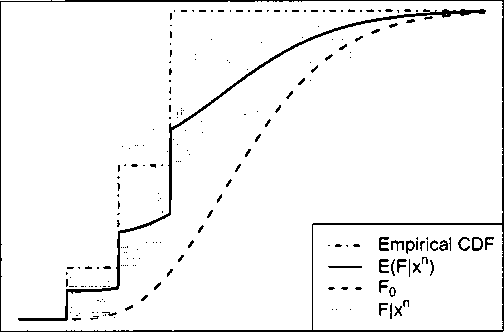44

Figure 3.1: Base measure Fo=Gα(9,2), posterior base measure Fi := F(F ∣ τn), empirical
cdf and set of simulated measures sampled from the posterior distribution of the DP (a =
5, Fo) when a sample xn: 1,2,2,3,3 and 3 of this DP was observed.
3.1 shows the base measure Fq=G<z(9,2), the posterior base measure F1, the empirical
cdf and a set of simulated measures sampled from the posterior distribution of the
DP(θ! = 5, F0) via (3.5) when the sample of size n = 6 of this DP: 1,2,2,3,3 and 3
was observed.
The DP allows analytic evaluation of the marginal distribution p(X1,... ,Xn),
integrating with respect to F ~ DP(a, F0). The marginal distribution is also known
as the Polya urn (Blackwell and MacQueen1 1973). We will exploit the Polya urn later
in this section to simulate from a DP. This representation, in particular, implies that
if Xι,... ,Xn is a random sample of this sample: X1,... ,X^ are a random sample
from Fq. This implies that
(3.6)
Pr[Xι ∈ ∙] = Fo(∙).
More intriguing information
1. The name is absent2. Modelling the Effects of Public Support to Small Firms in the UK - Paradise Gained?
3. The name is absent
4. 101 Proposals to reform the Stability and Growth Pact. Why so many? A Survey
5. GENE EXPRESSION AND ITS DISCONTENTS Developmental disorders as dysfunctions of epigenetic cognition
6. EXECUTIVE SUMMARY
7. The name is absent
8. Equity Markets and Economic Development: What Do We Know
9. Learning and Endogenous Business Cycles in a Standard Growth Model
10. Legal Minimum Wages and the Wages of Formal and Informal Sector Workers in Costa Rica